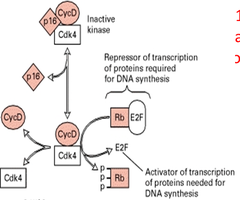Pathophysiology Quiz 2 (Cancer, Inflammation, Immunity, Diabetes) – Flashcards
Unlock all answers in this set
Unlock answersquestion
All death rates for cancers have _____________ except __________ __________.
answer
All death rates for cancers have DECREASED except LIVER CANCER.
question
_____% of men and _____% of women will be affected by cancer.
answer
43% of men and 38% of women will be affected by cancer.
question
Neoplasia
answer
Abnormal growth and proliferation (rapid reproduction) of genetically altered cells that are unresponsive or independent of growth control mechanisms.
question
What is cancer?
answer
A group of diseases that shares common features.
question
What are the common characteristics of cancer?
answer
abnormal cell growth, poor differentiation of cells, invasion of cells
question
Neoplasm
answer
tumor/new growth
question
What is metastasis? (general description)
answer
metastasis is secondary growth of a tumor that occurs away from the original site of the tumor due to transportation provided by the blood and lymph.
question
Cancer is the ___________ leading cause of death in the US behind ___________ ___________.
answer
Cancer is the SECOND leading cause of death in the US behind HEART DISEASE.
question
What are the environmental risk factors for cancer?
answer
chemical carcinogens, pollution, radiation, diet, sexual behavior, pharmaceutical agents, obesity, chronic inflammation
question
What are some examples of chemical carcinogens?
answer
tobacco, alcohol, drugs
question
What are some examples of radiation?
answer
UV rays, radiographs
question
What are some examples of pollution?
answer
asbestos, soil, radon, H2O
question
What about diet can cause cancer?
answer
food additives, high fat and low fiber
question
How can sexual behavior increase risk for cancer?
answer
STDs and increased sexual partners
question
What chronic inflammatory conditions can increase risk for cancer?
answer
HIV, hepatitis, h-pylori, bronchitis, pancreatitis
question
Differentiated
answer
cells that are recognizably the same as the original tissue that remain localized and provide a certain function for the body
question
Benign
answer
slow growing, differentiated cells that are not fatal or cancerous
question
Malignant
answer
rapidly growing, poorly differentiated cells that can spread to surrounding tissues and cause death
question
What are the two hallmark signs of a tumor under a microscope?
answer
anaplasia and pleomorphic
question
Anaplasia
answer
Cells that are not differentiated and are therefore not recognizable to the mature cells that are around it because they cannot carry out the same function as the cell they replaced.
question
Pleomorphic
answer
varied size and shape of cell
question
Carcinoma in Situ (CIS)
answer
a non-malignant, non-invasive tumor that can either go away on its own or develop into cancer
question
Carcinogenesis
answer
production of cancer
question
What are the four steps of carcinogenesis?
answer
1) initiation 2) promotion 3) progression 4) metastasis
question
Initiation
answer
genetic mutation or exposure to something that causes the cell to change
question
Promotion
answer
continuing change of the cell after the genetic mutation or exposure (follows initiation)
question
Progression
answer
When the cells have become cancerous and deposit somewhere in the body to form a tumor that continues to grow
question
Metastasis
answer
cells break off original site and move to other places in the body
question
What are the five phases of metastasis?
answer
primary site invasion --> cell detachment into the blood or lymph (can be stopped by immune system @ this point) --> dissemination (spreading) --> secondary site attachment --> proliferation (growth) at new site
question
Oncogene

answer
the mutated form of normal genes that promote proliferation and survival; cheerleader for cancer
question
Tumor suppressor genes

answer
inhibit cell proliferation and promote cell death or DNA repair; grim reaper of cancer
question
Angiogenesis
answer
growth of new BVs to provide advanced cancerous cells greater than 1mm with oxygen and nutrients for continued growth
question
What are the different neoplasms of epithelial origin?
answer
papillomas, adenomas, polyps, carcinomas, adenocarcinomas
question
Papillomas
answer
benign finger-like growths on the squamous and basal cells of the skin, BVs, and vocal cords
question
Adenomas
answer
benign growth in glandular tissue particularly breast tissue, prostate, and pituitary glands
question
Polyps
answer
papillomas or adenomas that grow at the end of a stem in a mucous membrane and are usually benign but can be pre-cancerous
question
Carcinomas
answer
malignant and invasive
question
adenocarcinoma
answer
glandular and malignant
question
What are the two types of neoplasms with connective tissue origin?
answer
sarcoma and osteoma
question
sarcoma
answer
malignant and occurring in the muscle cells
question
osteoma
answer
benign and occurring in the bone
question
What two types of neoplasms have a neural tissue origin?
answer
glioma, glioblastoma (astrocytoma)
question
Glioma
answer
a benign encapsulated tumor
question
Glioblastoma/astrocytoma
answer
malignant
question
What is a neoplasm called that forms in the lymphatic tissue?
answer
lymphoma
question
What is a neoplasm that forms in the blood?
answer
leukemia
question
What are two examples of cancer named after someone?
answer
Ewing sarcoma and hodgkin's lymphoma
question
Biopsy
answer
taking some of the tissue out of the body for testing, can be done by needle aspiration or punch biopsy
question
What are tumor markers?
answer
substances released from the tumor that can be detected in the tumor itself, the blood, bodily fluid or urine
question
What are the different types of tumor markers?
answer
hormones, enzymes, genes, antigens, antibodies
question
What are the purposes for grading and classifying cancer?
answer
1) so it can be described easily to the pt. 2) determine treatment aggression 3) determine survival rate 4) quality and method of treatment 5) exchange info b/w treatment centers
question
What does TMN stand for when determining the staging of cancer?
answer
T = tumor (size or extent of invasion rated 1-4) M = metastasis (yes or no? rated 0-1) N = nodes (extent of lymph node involvement; rated 0-3)
question
What are the clinical manifestations of cancer?
answer
pain, fatigue, cachexia, anemia, leukopenia, thrombocytopenia, oral ulcers, malabsorption, diarrhea, GI obstruction, alopecia, skin breakdown and dryness from lack of epithelial renewal
question
What causes cancer to be painful?
answer
The cancer itself is not painful, it is the invasion and compression of the healthy tissue or any nerve irritation that occurs from the abnormal cell growth.
question
What is the most common sign of cancer and treatment?
answer
fatigue
question
Cachexia
answer
loss of appetite due to early satiety (feeling full) that causes weakness, weight loss, changes in metabolism and changes in taste due to treatment
question
Anemia
answer
low hemoglobin and hematocrit caused by malnutrition, chronic bleeding and/or iron deficiency
question
Leukopenia
answer
low WBC count
question
Thrombocytopenia
answer
low platelet count which decreases clotting ability
question
alopecia
answer
hair loss from chemo
question
What are your body's lines of defense?
answer
skin and mucous membranes, inflammation, specific immune responses
question
Inflammatory Response
answer
beneficial response to invasion of microorganism or injury
question
What are the two phases of tissue reaction to injury?
answer
cellular phase and vascular phase
question
Vascular phase
answer
involves chemical mediators from the plasma or cells that are released into the tissue when it is damaged
question
What is a "compliment" during the vascular phase?
answer
a system of proteins that acts as the major mediator and enhances chemotaxis, increases vascular permeability and causes cell lysis
question
What do 'kinins' do?
answer
contribute to pain and fever and specifically bradykinin causes vasodilation
question
Histamine
answer
mast cells and basophils release this for potent vasodilation and increased capillary permeability
question
What do serotonin and leukotrienes do?
answer
they are similar to histamines in the fact that they are vasodilators, but they are also bronchoconstrictors and react more slowly than histamines
question
Prostaglandins
answer
increase the effects of histamine and pain response to injury while also promoting platelet aggregation so a clot can be formed
question
Hemostatic-fibrinolytic system
answer
This is the end point and the first step in putting returning the BVs back to normal and getting rid of the clot when it is no longer needed.
question
What vascular changes result from these chemical mediators?
answer
vasoconstriction --> vasodilation --> increased capillary permeability --> fluid leaks from intravascular to interstitial space --> edema --> stimulation of pain receptors
question
cytokines
answer
regulators that enhance the vascular phase
question
interleukins
answer
stimulate the liver to produce plasma proteins because a lot are being lost through leakage
question
interferon
answer
blocks receptor site from virus so it can't bind and invade the cell; does not kill the virus
question
Tissue Necrosis Factor (TNF)
answer
increases the body's fever response because neutrophils work better at higher temperatures (to a point)
question
Cellular phase
answer
a WBC response causing phagocytosis
question
What are the steps of the cellular phase?
answer
margination --> emigration of leukocytes--> phagocytosis --> formation of exudate --> fibrin barrier formation
question
What happens during margination?
answer
the granulocytes come in and fight off the infection and the phagocytes move to the periphery of the BVs and "eat up" the foreign bodies that the granulocytes were fighting; note: monocytes are used more in chronic inflammation and granulocytes are for acute
question
What are the three types of granulocytes?
answer
neutrophils, basophils, eosinophils
question
Neutrophils
answer
primary responder that will elevate to the greatest extent
question
What happens when the leukocytes emigrate?
answer
WBCs migrate to the area of infection (chemotaxis)
question
What happens during phagocytosis?
answer
the target is recognized and neutrophils and macrophages start to engulf the pathogen which is then ingested through fusion with the lysosomes in the phagocyte. The lysosomal enzymes then destroy the foreign substance.
question
What are the local responses to inflammation?
answer
increased tissue temp, redness, swelling, pain, formation and removal of exudate
question
What are the systemic effects of inflammation?
answer
fever, increase in circulating plasma proteins, leukocytosis, lymphadenopathy
question
Fever
answer
initiated by the release of pyrogens that act on the hypothalamus to raise the body's thermostat
question
Leukocytosis
answer
elevation in WBC count
question
lymphadenopathy
answer
enlarged lymph nodes
question
Adaptive immunity
answer
endogenous chemicals in cellular system that enhances specific activity/materials present w/in an environment
question
immune deficiency
answer
too little or nonresistant response to a foreign antigen with infections being the most common foreign antigen
question
hypersensitivity
answer
too much of a response to an antigen
question
immunodeficiency
answer
impairment of the immune system
question
What are primary immunodeficiencies?
answer
people are born with them



